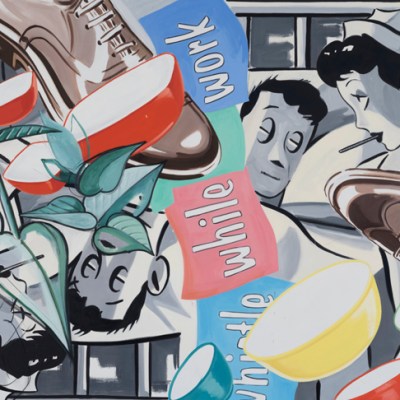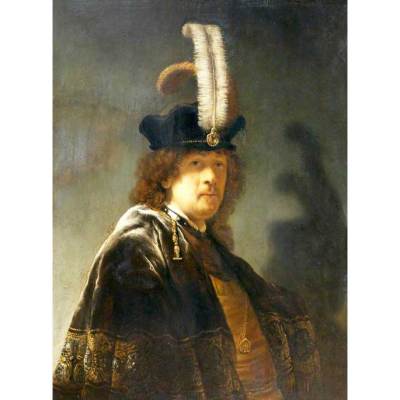There is something profoundly uncanny about seeing Cindy Sherman in person for the first time. When she greets me at the door of her SoHo studio one afternoon in April, casually dressed and wearing no obvious make-up, I recognise her features, but not, exactly, her face. For more than 40 years, Sherman has appeared in nearly all of her work, but never as herself. With the help of stage make-up, prosthetics, wigs, costumes and, more recently, digital tools, she has shapeshifted into hundreds of characters, among them B-movie ingénues, terrifying clowns, Renaissance Madonnas, and society matrons. I catch myself staring more than once during our conversation, wondering how she manages to transform herself so thoroughly in her photographs that her face seems unfamiliar even though I’ve seen it so many times.
Her studio, however, is much like what I’d imagined: spacious and orderly, but filled with all sorts of oddities. One corner is dominated by a green screen and littered with studio lights and camera equipment. The windowsills are lined with wigs on stands, while shelves display neat rows of boxed costumes, props, mannequin heads, and prosthetic body parts. Framed artworks mingle with print-outs and magazine pages tacked haphazardly to the walls. ‘I change these when I’m really working on something, when I need different frames of reference,’ she says, gesturing towards one group of pictures in which 1920s Hollywood actresses feature prominently. These are mostly left-over reference images for Sherman’s recent Flappers series (2016–18), in which she appears in the guise of ageing former starlets, many of them seemingly unaware that they are past their primes as they pose for glamour shots in flapper dresses with heavy period make-up. The eclectic objects that dot the studio’s work tables – I spot, among other things, a pair of oversized rhinestone sunglasses, a painted barbershop sign, and various old toys – are largely ‘stuff that I’ve collected from flea markets and other weird places over the years, just in case I want to use them as props’. She points to a pair of miniature crowns: ‘I just got those at the Paris flea market, and I don’t know what I’m going to use them for, but it seemed like they had the potential for something. I love weird stuff; a good, weird flea market anywhere is really my favourite place to be.’
Cindy Sherman photographed in her studio in New York in Aprill 2019. Portrait: Nina Subin

Sherman is currently preparing for a retrospective at the National Portrait Gallery in London this summer (27 June–15 September). It will include examples of all Sherman’s major bodies of work – including all 70 photographs from her breakthrough series, the Untitled Film Stills (1977–80), as well as a number of rarely exhibited works from the mid 1970s. Sherman has been actively involved in the selection, she tells me, introducing the exhibition’s curator Paul Moorhouse – the author of a 2014 Phaidon monograph on Sherman’s photographs – to several ‘earlier pieces that he didn’t even know about’.
These include the Cover Girl series (1976; Fig. 3), made while Sherman was an art student at State University College at Buffalo in upstate New York. The five works in the series are comprised of a trio of women’s magazine covers: in each, the first image is a real cover, from Cosmopolitan, Vogue, Family Circle, Redbook, and Mademoiselle, respectively; for the second, Sherman replaced the model’s face with her own, painstakingly copying the original make-up and pose, while the third shows Sherman making an unflattering or playful face – a send-up of the impossible standards of femininity such magazines promoted. ‘I guess I neglected [the series], because it was really early work. I never thought about it; it was just in a file somewhere,’ Sherman says.
Cover Girl (Vogue) (1976/2011), Cindy Sherman. Private collection, Paris. Courtesy the artist and Metro Pictures, New York; © Cindy Sherman

Arguably, Sherman’s experiments with masquerade began when she was growing up in suburban Long Island. She was the youngest of five children – a 19-year age gap separated Sherman and her eldest sibling – and has often explained her early enthusiasm for dressing up as unusual characters as a means of commanding attention as the baby of the family (in an interview with the Guardian in 2011, she said she felt like ‘a total latecomer’ within an already established household). She was also drawn to photographs, if not yet photography. When Sherman was in elementary school – she’s not sure exactly how old she was, but it was somewhere around eight – she began compiling an album of family snaps that she titled ‘A Cindy Book’, drawing a circle around herself in each image and captioning it, ‘That’s me’. ‘When I’d look through [boxes of family photos], I’d always ask my mother “Which one of those is me?” I guess it became interesting to me to pick myself out of a group of people,’ Sherman tells me.
The photographs in the album, which is being exhibited for the first time, chart her changing appearance as she ages from an infant to a pre-teen. In college, she discovered the half-finished book, and decided to complete it. She was by that point already photographing herself in her work and recognised, in the album, that a similar impulse had been present from a young age. ‘The difference, and I think it’s a big difference,’ she says, ‘is that […] I’m trying to erase myself more than identify myself or reveal myself. That’s a big, confusing thing that people have with my work: they think I’m trying to reveal these secret fantasies or something. It’s really about obliterating myself within these characters.’
Untitled #92 (1981), Cindy Sherman. Courtesy the artist and Metro Pictures, New York; © Cindy Sherman

After college, in 1977, Sherman moved to New York City with her then-boyfriend, the artist Robert Longo, and began working on what would become the Untitled Film Stills: a series of black-and-white photographs modelled on promotional images for 1940s and ’50s movies, in which she cast herself in different archetypal female roles. Sherman so convincingly appropriated cinematic codes that many early viewers believed that they could identify the specific scene she had supposedly ‘recreated’. The photographs were almost immediately celebrated by critics and curators, establishing her reputation as a leading artist of the ‘Pictures Generation’. (Their status was cemented in 1995 when the Museum of Modern Art acquired a complete set of the Untitled Film Stills, for a reported $1 million.) Soon after came Centerfolds (1981) – originally commissioned by Ingrid Sischy for Artforum, but never published – in which she turned the men’s-magazine centrefold format on its head, staging scenes that suggest fear or vulnerability, or even the aftermath of violence.
Sherman’s photographs elicited reams of dense critical writing from the outset, much of it by the circle of critics and art historians associated with the influential journal October: in its play with the mutability of identity and the language of mass media, her work was received as a perfect articulation of then-nascent theories of postmodernism. When I ask Sherman if she has ever been interested in the extensive theoretical discourse around her work, she laughs: ‘No, no. There’s still a lot I’ve never even read, and some that I’ve tried to read and didn’t even understand.’ Her response to an essay by Rosalind Krauss in a 1993 monograph, for instance, was ‘headscratching, like, “What is she talking about?”’ Among the most outlandish interpretations she has encountered, she says, is a short film – Bertrand Bonello’s Cindy: The Doll is Mine (2005) – that imagines Sherman at work in the studio. ‘The actress playing me is just struggling, like “Oh it’s so torturous,” […] and I thought “Wow that is so not true.” I’m having fun when I’m working, even when I’m doing really dark subjects.’
Untitled #574 (2016), Cindy Sherman. Courtesy the artist and Metro Pictures, New York; © Cindy Sherman

Sherman describes her process as largely intuitive: she tests out ideas as they pop into her head, playing around with garments or props until she hits on a promising character. The Clowns series (2003–05), for instance, was inspired by a ‘really funny pair of pyjamas that had been turned into a clown suit’. Sherman worked on the History Portraits (1988–90) during a fellowship in Rome, using cheap fabrics and obvious prostheses to loosely recreate Old Master paintings. She conceived of her Flappers pictures after finishing a group of photographs commissioned by Pop magazine, in which she is seen wearing elaborate couture outfits from the Chanel archives against digitally inserted backdrops of rural Icelandic scenery. Because she was afraid of staining the garments with her make-up, she relied entirely on post-production editing to manipulate her facial features. Afterwards, she ‘started ripping out images from magazines of heavy, intense make-up and weird eyebrows. It was just because I wanted to play around with make-up again.’
When Sherman is shooting, she’s entirely by herself, acting as photographer, model, make-up artist, hair stylist, and costumer: ‘It’s just me, and a mirror and a camera and a backdrop, and that’s about it.’ Being alone in the studio allows her to work without inhibitions. ‘I’ve always felt that I’m able to be a little more experimental because no one is around if it doesn’t go well,’ she says. Digital photography and editing tools have also enabled her to work more fluidly: ‘In the past I would shoot, say, two rolls of film, and then I’d take all my make-up off, get out of character, bring it to the lab, and then wait a couple of hours for it to be developed.’ If something went wrong – the image was out of focus, or the lighting was off – she’d have to start all over. Working digitally, ‘I can start without really any idea in my mind and just be fooling around in front of the camera, take a few shots and look at them on my computer and say, “Well that’s a good direction to go in, let’s work with that kind of character.”’
Untitled #587 (2016/18), Cindy Sherman. Courtesy the artist and Metro Pictures, New York; © Cindy Sherman

In Sherman’s most recent series, which will be exhibited for the first time as part of the retrospective, she takes up a distinctly contemporary type: the fashion ‘influencer’, a ubiquitous presence on style blogs and social media. The works originated with a commission from Harper’s Bazaar in 2016, proposing that she take on the theme of street style. She nicknamed the series ‘Project Twirl’: ‘These women go to [runway shows] and have their limos let them off like two blocks before the show, so they can walk in front of all the photographers and do a little twirl, or a little dance, and get their photographs taken. That just seemed hysterically funny – to be like, “Me, me, me, take my picture.”’ Sherman perfectly apes the affected, faux-casual poses and absurd, camera-grabbing outfits characteristic of the format: in one, she wears a sleek black wig and a mint-green Gucci pantsuit emblazoned with eyes and a mouth, with her hands resting in her pockets, and a hint of a smile; in another, four versions of the same woman – a perfectly coiffed blonde wearing an oversized hoodie – test out different poses.
Sherman has often taken on fashion collaborations, beginning with a series of ads for the boutique Dianne B, which ran in Interview magazine in 1983. Although she wore outfits by Jean-Paul Gaultier and Comme des Garçons, among other labels, the photographs were intentionally unglamorous, participating in the business of fashion advertising only to subvert its conventions. Now, she says, she often accepts fashion and magazine commissions when she hasn’t created new work in a while and needs a burst of inspiration. ‘When I’m shooting, it’s such an intense time for me that I need to get away from it and sort of forget about it. But sometimes it’s really hard [afterwards] to get back into the whole process,’ she says. The collaborations are ‘a way for me to feel like I’m getting kickstarted into getting back to work’.
In Harper’s Bazaar, Sherman’s street-style models appeared against digitally inserted scenes capturing the bustle outside real fashion shows. While that worked for print, ‘It didn’t really translate in my mind as a big blown-up photograph.’ Over the next two years, she experimented with backgrounds in an attempt to make the images seem ‘a little more iconic’. For the versions in the exhibition, the women appear against various unpopulated landscapes, making their desperate bids for attention seem all the more absurd as they pose for an absent crowd. The works are printed on metal, using a dye-sublimation process she first employed in the Flappers series. Sherman becomes visibly excited discussing the technical side: the process not only offers richer colour, but also allows her to exhibit the prints without glass, so the experience of viewing them ‘seems more immediate: there’s no reflection, so you’re not really aware of yourself as the viewer looking at the image.’
Untitled #204 (1989), Cindy Sherman. Philadelphia Museum of Art. Courtesy the artist and Metro Pictures, New York; © Cindy Sherman

At the start of Sherman’s career, the idea of constantly photographing oneself was, as Moorhouse notes in the NPG catalogue, fundamentally a bit strange. Today, it’s as mundane an activity as reading a newspaper – probably more so – making Sherman, once again, seem eerily prescient. When I ask if she sees her work anticipating a culture of selfies and social-media performance, she demurs: ‘I don’t think of it like that; I can see the connection, but with completely different goals.’ More recently, however, she has begun to experiment with the selfie format on her Instagram, though she approaches it with a characteristically rebellious spirit, using apps such as Facetune and Perfect365 against the grain – to contort her face into bizarre, alien forms rather than erase its imperfections. ‘I think of [Instagram] more like a sketchbook,’ she says. ‘It’s broadened my feelings about what’s possible with backgrounds and filters. I’m trying to think of ways to make work from it;I can’t really turn them into [prints] because the quality’s just not good enough to make them big.’ She has, instead, been considering unconventional media: a friend, for instance, is turning her posts into hand-carved cameos.
Given that Sherman has always been adamant that her photographs are not self-portraits, I ask how she characterises her warped and filtered images on Instagram, where they occasionally sit side by side with straight snapshots from her life. ‘I guess technically they’re pictures of me, but not, because I’m doing all these weird things to my face so it doesn’t look anything like me.’ As in all of her work, she wants the artifice to be evident. ‘I always want [my photographs] to be a little off, whether it’s the background not quite fitting in or, in the old work, you’d see the shutter cord, or be able to tell that I’m using fake tits or a fake nose. Everybody knows it’s not real anyway.’
‘Cindy Sherman’ is at the National Portrait Gallery, London, until 15 September.
From the June 2019 issue of Apollo. Preview and subscribe here.



